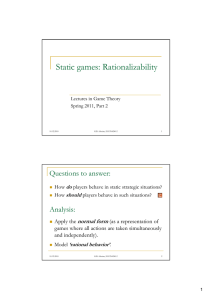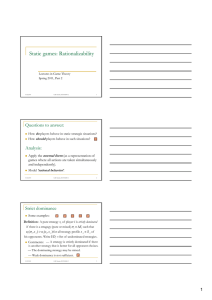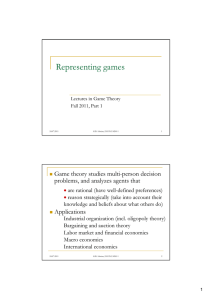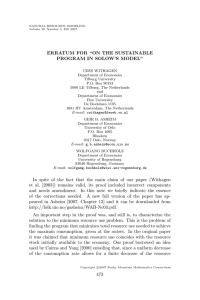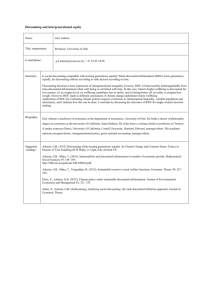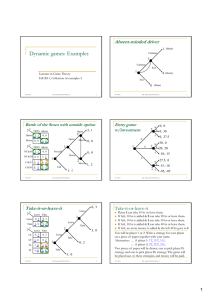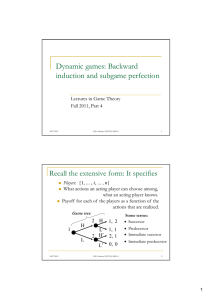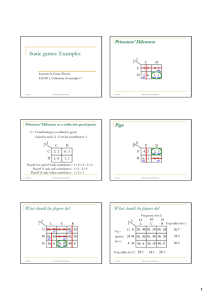Static games: Rationalizability g y Questions to answer:
advertisement
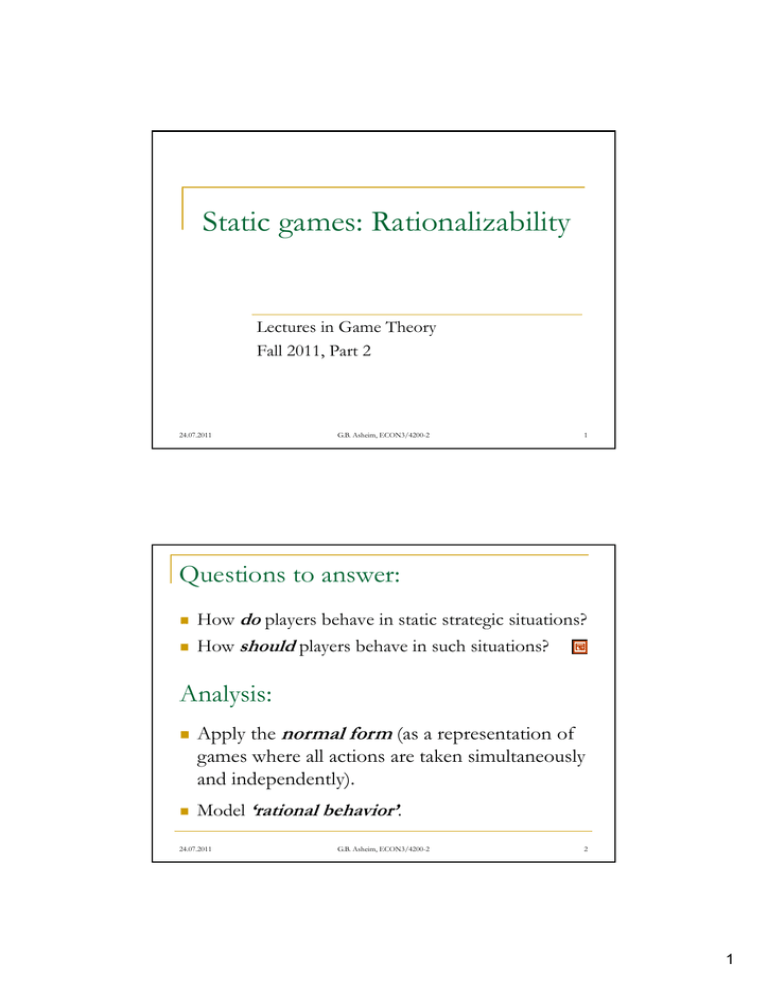
Static ggames: Rationalizabilityy
Lectures in Game Theory
Fall 2011, Part 2
24.07.2011
G.B. Asheim, ECON3/4200-2
1
Questions to answer:
How do players behave in static strategic situations?
How should players behave in such situations?
Analysis:
Apply the normal form (as a representation of
games where all actions are taken simultaneously
and independently).
Model ‘rational behavior’.
24.07.2011
G.B. Asheim, ECON3/4200-2
2
1
Strict dominance
Some examples:
Definition : A p
pure strategy
gy si of p
player
y i is strictlyy dominated
if there is a stragegy (pure or mixed) i Si such that
ui ( i , si ) ui ( si , si ) for all strategy profile si S i of
his opponents. Write UDi Set of undominate d strategies .
gy is strictlyy dominated if there
Comments: — A strategy
is another strategy that is better for all opponent choices.
— The dominating strategy may be mixed.
— Weak dominance is not sufficient.
24.07.2011
G.B. Asheim, ECON3/4200-2
3
Simple theory of individually rational behavior:
Players do not use strictly dominated strategies.
Player i chooses some si UDi
First tension: Individually rational behavior may
not lead to collectively efficient outcomes.
The concept of efficiency
Definition : A strategy profile s ( s1 , , si , , sn ) is
(Pareto) efficient if there is no other strategy profile
s ( s1, , si, , sn ) such that ui ( s) ui ( s ) for
every player i and u j ( s) u j ( s ) for some player j.
24.07.2011
G.B. Asheim, ECON3/4200-2
4
2
Equivalent
Alternative theory of individually rational behavior:
Players use strategies that can be best responses.
Definition : Suppose player i has a belief i S i
about the strategies played by his opponents.
Player i' s strategy si Si is a best response to i if
ui ( si , i ) ui ( si, i ) for every si Si .
Write BRi ( i ) Set of best respo nses to i , and
Bi {si | there
h is a belief
b l f i S i such
h that
h si BRi ( i )}.
Player i chooses some si Bi
24.07.2011
G.B. Asheim, ECON3/4200-2
5
Strict dominance and best response compared
Observations for two-player games:
– If a strategy is not strictly dominated, then it is a
best response to some belief.
– If a strategy is strictly dominated, then it is not a
best response to some belief.
Result : In a finite two - player gam e, B1 UD1 and B2 UD2 .
In ggames with more than two players,
p y
the
equivalence between strict domianance and best
response is obtained if beliefs are correlated.
Result : In a finite game, Bi Bic UDi for each i 1,2, , n.
24.07.2011
G.B. Asheim, ECON3/4200-2
6
3
Algorithm for finding Bi UDi
in two-player games
Step 1: Strategies that are best
b responses to
simple (point mass) beliefs are in Bi.
Step 2: Strategies that are dominated by other
pure strategies are not in Bi.
Step 3: Other strategies can be tested for mixed
strategy dominance to see whether they are in Bi.
24.07.2011
G.B. Asheim, ECON3/4200-2
7
Sophisticated theory of individually rational behavior:
Iterated strict dominance
(Iterated elimination of strictly dominated strategies)
Some examples:
In two-player games, iterated strict dominance is
equivalent to the procedure in which strategies that
are never best responses are removed in each round.
Rationalizability
SStrategies
i that
h survive
i iiterated
d strict
i ddominance
i
are
called rationalizable strategies.
Weak dominance is not sufficient.
24.07.2011
G.B. Asheim, ECON3/4200-2
8
4
Two problems with iterated strict dominance
1. It is based on an assumption that it is commonly
players
y choose rationally.
y
believed that p
2. In many games there are no strictly dominated
strategies.
Second tension: Common belief of individually
rational behavior
b
may not lead
d to coordination.
d
Question: How to analyze games where iterated
strict dominance has no bite?
24.07.2011
G.B. Asheim, ECON3/4200-2
9
5
